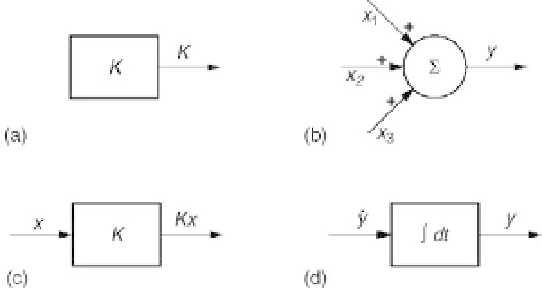Biomedical Engineering Reference
In-Depth Information
FIGURE A.7
Basic drawing elements in a block diagram: (a) constant, (b) summer, (c) gain, and (d) integrator.
logarithmic functions. The basic drawing elements for the block diagram are shown in
Figure A.7.
To create a block diagram, we first take the highest derivative term output variable and
put it on the left-hand side of the equal sign and the other terms on the right-hand side.
Next, the block diagram is formed by connecting elements on the right-hand side to a sum-
ming junction representing the equation side, with the output being the left-hand side of the
equation. From the summer, we include as many integrator blocks as necessary to reduce
3
d
y
the highest order derivative to the output variable (i.e.,
3
requires three integrators).
Finally, we use a gain block and connect the output variable and lower-order derivatives
to appropriate gain blocks back to the summer. If there are any inputs, these are added to
the summer using a constant block for a unit step function, or an appropriate function block
such as
dt
e
t
.
t
,or
EXAMPLE PROBLEM A.6
Draw a block diagram for
¨
þ
4
y
þ
3
y
¼
0.
Solution
To begin the process of drawing a block diagram, the differential equation is rearranged as
y
¼
4
y
3
y
and the block diagram is started by drawing the summer as shown in the following figure.
ÿ
Σ
−
3
y
−
4
y
y
Next, we insert two integrator blocks to the output of the summer to obtain
and
y
as
illustrated in the following diagram.
Continued









